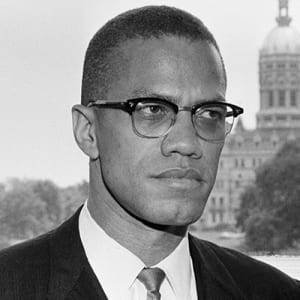On February 2,1965, Malcolm X was speaking at an Organization of Afro-American Unity event at Manhattan’s Audubon Ballroom when a group of men suddenly rushed to the podium and fatally shot him several times. Three Nation of Islam members were held responsible for the shooting and convicted in 1966.
Malcolm X’s death shocked the world considering he was such a charismatic leader. He had become known as a champion of human rights from the moment he split with the Nation of Islam (NOI) following ideological differences between him and NOI leader Elijah Muhammad. To date, there have been talks about how Louis Farrakhan, minister of the Nation of Islam, was accused of being responsible for his death. Farrakhan, who was Malcolm X’s Muslim disciple before turning rival, had said at the time that he had no role in Malcolm X’s murder.
There are also discussions about how the New York Police Department (NYPD) and the FBI may have played a role in the assassination of Malcolm X largely thanks to what he was working on before he was killed.
Malcolm X faced poverty and violence growing up before becoming an influential Black leader of the 1960s American civil rights movement. He did not believe in non-violent, civil disobedience as the means to attack racial prejudice in America unlike other Black leaders like Martin Luther King, Jr. Malcolm X wanted a more militant approach to achieving equal rights for Black people by “any means necessary.”
But after leaving the Nation of Islam in 1964, saying that the group was refusing to take a more active role in the fight for civil rights, a new Malcolm X emerged.
In April of 1964, the iconic Black leader visited North Africa and the Middle East, and these visits helped change his views on race in America. He began softening his stance. Seeing White Muslims and Black Muslims united during his visit to Mecca changed how he viewed racism.
Read Also:
Black Legacy: A Retrospective Capture Of Sidney Poitier’s Legacy In Film And Activism
During his final days before his assassination, Malcolm X was building the Organization of Afro-American Unity (OAAU), a Pan-African organization that was modeled on the Organization of African Unity, which had impressed Malcolm X during his visit to Africa in 1964. He had had prior visits to the continent with his first in 1959 when he touched down in the United Arab Republic (a short-lived political union between Egypt and Syria), Sudan, Nigeria, and Ghana to make arrangements for a tour by Elijah Muhammad.
He also visited Africa after his pilgrimage to Mecca in 1964 and conducted interviews and gave speeches in Egypt, Ethiopia, Tanganyika, Nigeria, Ghana, Guinea, Sudan, Senegal, Liberia, Algeria, and Morocco after meeting their leaders. Malcolm X was enlightened by Pan-African leaders such as Kwame Nkrumah of Ghana, Gamal Abdel Nasser of Egypt, and Ahmed Ben Bella of Algeria who were stalwarts of African unity and wanted him to work with them.
The impressed Malcolm X returned to the United States in May 1964 and formed the OAAU in June to fight for the human rights of Black Americans and foster unity with Africans and all people of African descent. He announced the establishment at a public meeting in New York’s Audubon Ballroom on June 28, 1964, after writing the group’s charter with other Pan-Africanists including John Henrik Clarke, Albert Cleage, Jesse Gray, and Gloria Richardson.
Two months later, he returned to Egypt for the second Organization of African Unity meeting as a representative of the Organization of Afro-American Unity (OAAU). Ahead of his trip to Africa, FBI Director J. Edgar Hoover wrote in a memo dated July 2, 1964, that the OAAU was a threat to the national security of the United States. The FBI had wanted to convict Malcolm X under the Logan Act, which forbids “negotiat[ing] with foreign governments having a dispute with the United States.” The memo accused Malcolm X of meeting Communist China in Africa.
Malcolm X returned to the United States and started laying a solid foundation for the OAAU under the four pillars of Restoration, Reorientation, Education, and Economic Security of Black people. His OAAU aimed to foster pan-African consciousness.
“Malcolm X saw the OAAU as a way of “un-brainwashing” Black people, ridding them of the lies they had been told about themselves and their culture,” according to a report by the AAREG.
The OAAU did not allow Whites to join. When Malcolm X was at the meeting of the Organization of African Unity in Egypt as a representative of the OAAU, a reporter asked the influential Black leader whether White people could join the OAAU. “Not”, Malcolm X replied.
Malcolm X had hoped to do more with his OAAU by reconnecting African Americans with their African heritage and encouraging African-American self-determination but his life was cut short. His death while preparing to address the OAAU in Manhattan’s Audubon Ballroom marked the end of the organization. His half-sister Ella Little-Collins assumed leadership but membership dwindled due to Malcolm X’s absence and the organization eventually collapsed. That notwithstanding, the OAAU inspired scores of Black power groups established after his death.
Curiously, during his last days, Malcolm X had told his wife, Betty, that he is likely to die violently. He had advised her on how to live and take care of their daughters in his absence even though the family would continue to endure misfortune. Last year, a judge exonerated Muhammad Aziz, 83, and Khalil Islam, two of the three men convicted of Malcolm X’s killing.

